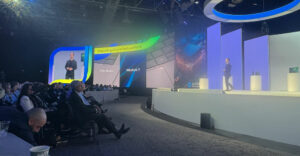
The Department of Energy’s National Nuclear Security Administration (NNSA) has tapped IBM to build a massive new supercomputer that will deliver a record-breaking 20 petaflops of computing power.
The proposed supercomputer is nicknamed “Sequoia,” and it’ll come with 500 teraflop sidekick, Dawn. Both computers will be delivered to the Lawrence Livermore National Laboratory where, according to NNSA, they’ll “help continue to ensure the safety and reliability of the nation’s aging nuclear deterrent.”
IBM will deliver Dawn in the first quarter of 2009. Dawn is based on IBM’s BlueGene/P architecture, while Sequoia, which will be deployed in 2012, is based on a future BlueGene technology. Details are sparse, but IBM said Sequoia will include 1.6 million IBM Power processors housed in 96 refrigerator-sized racks. It’ll take up 3,422 square feet of data center space, and it’ll also be more powerful than the combined performance of all the systems on today’s list of TOP500 supercomputers.
“Holy moly. It just seems like last year that we passed sustained performance of one petaflop — and hey, it was last year,” Charles King, principal analyst for Pund-IT, told TechNewsWorld.
“You’re talking about a remarkable jump in performance, certainly. I could be wrong, but I think it’s likely that unless somebody comes up with a different supercomputing architecture, I can’t imagine any of the competing architectures scaling up to that degree as quickly as IBM has been able to accomplish with BlueGene. It’s likely they will be dominating the TOP500 list for quite a while to come,” he added.
Is That Fast?
With a speed of 20 petaflops — or 20,000 trillion calculations per second — Sequoia is expected to be the most powerful supercomputer in the world, IBM said, and will be approximately 10 times faster than today’s most powerful system. To put this into perspective, if each of the 6.7 billion people on Earth had a hand calculator and worked together on a massive calculation for 24 hours per day, 365 days a year, it would take 320 years to do what Sequoia will do in one hour, according to Big Blue.
Sequoia will boast 1.6 petabytes of memory, run on Linux, and deploy a state-of-the-art switching infrastructure that will take advantage of advanced fiber optics, IBM said.
What Will It Do?
Sequoia and Dawn will serve NNSA’s tri-lab Advanced Simulation and Computing (ASC) program, which unites the scientific computing resources and expertise of Los Alamos, Sandia and Lawrence Livermore National Laboratories. The labs will run extremely complex simulations, including simulations that will ensure the safety and reliability of the nation’s nuclear weapons stockpile, which could negate the need for real-world weapon testing.
Sequoia and Dawn will also be used for research into astronomy, energy, human genome science and climate change.
The machine will be built, tested and benchmarked in IBM’s Rochester, Minn. plant.
Beyond Nuclear Physics
Aside from the primary nuclear-related simulations, a 20 petaflop supercomputer would result in a 40-fold jump in the ability of scientists to monitor and forecast weather, according to IBM. This would allow forecasters to predict local weather events that affect areas 100 meters to one kilometer in size, down from their current 10-kilometer ability, IBM said. Weather forcasters could more easily and accurately predict tornadoes, which are local events generally confined to a few kilometers. They could then more accurately map the twister’s path.
Additionally, according to researchers at Lawrence Livermore, a 20-petaflop machine would deliver a 50-times improvement in scientists’ capability to predict earthquakes and map out safe evacuation routes. This would let scientists predict an earthquake’s effects on a building-by-building basis across an area as large as Los Angeles County.





















































when will this be available in a desktop? hehe
can anyone say skynet dum da dum dum